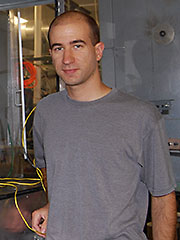Keith Gneshin
Coal power without Coal Mining?
By Stacy Kish on August 4, 2010

Keith Gneshin standing next to the new coal reactor that he built for studying the pyrolysis of large blocks of coal.
Fellow: Keith Gneshin
Hometown: Cottonwood Heights, UT
Undergrad: Colorado School of Mines
Graduate school: University of Utah
Keywords: Department of Energy, American Recovery and Reinvestment Act, Office of Science, Graduate Fellow program, Coal, Carbon Dioxide Storage
Coal remains one of the primary materials to produce electricity. Bringing coal to the planet’s surface and burning it produces a host of environmental complications. But there may be an alternate method. “We can create fuels that we require to operate society on a day-to-day basis and reduce environmental impact of using these resources.” says Keith Gneshin a DOE Office of Science Graduate Fellow and doctoral candidate at the University of Utah.
Gneshin’s research is focused on how to cleanly and safely use America’s coal resources without removing the coal from the ground. Gneshin explains that his research interest is in pyrolysis – the science of breaking chemicals down by heat. “In simplest terms my research is similar to sticking a heater into a seam of coal and heating it.” The goal of research is to determine the temperature and how quickly a coal bed can be heated to create different types of fuels. Gneshin says the technology for this is based on deep coal seams, more than 0.5 miles below the surface. Gneshin admits that this approach is new, but it is similar to underground coal gasification, which has been studied more in-depth.
“The aim of my work is to generate a fully-integrated picture of underground coal pyrolysis that includes not only an understanding of how different methods affect the quantity and composition of fuels (both gas and liquid) produced, but also an understanding of the residual carbon matrix left in the ground,” said Gneshin. The newly opened underground reservoirs could be used to return and store atmospheric carbon dioxide creating a zero emissions process.
Gneshin concludes, “The graduate fellowship provides me with a greater ability to go to conferences and talk about my work and an easier path of access to speak with people in the public and private sectors interested in these technologies.” Gneshin’s graduate fellowship is funded by the American Recovery and Reinvestment Act of 2009.
Stacy Kish is a Science Writer with the Office of Science


